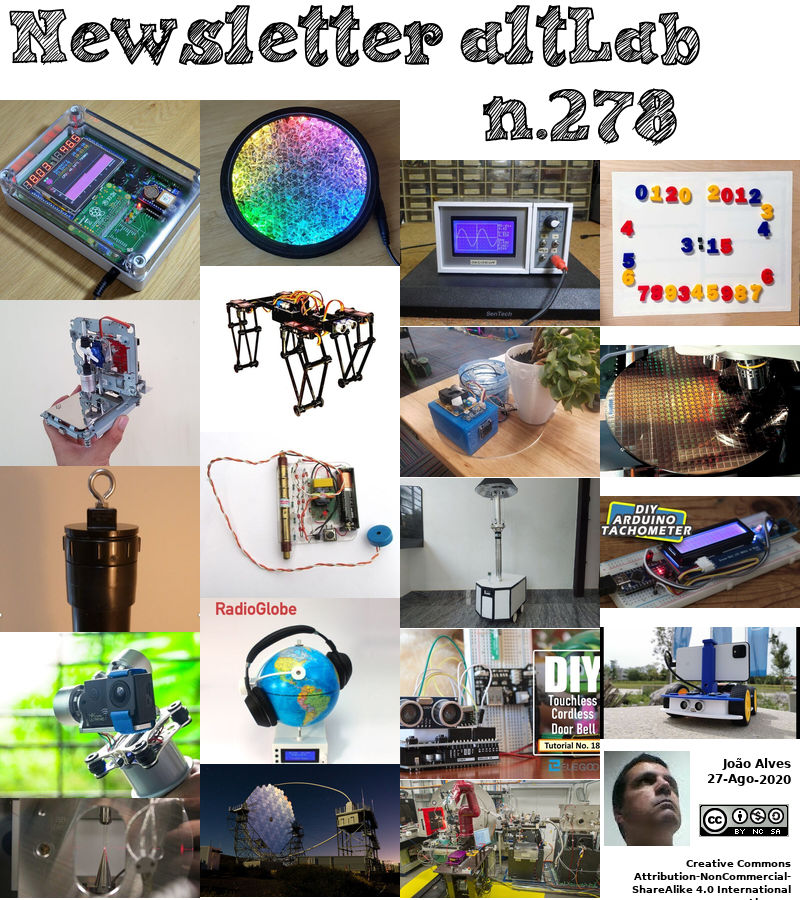2020-08-27 - Nº 278
Editorial
Esta é a Newsletter Nº 278 que se apresenta com o mesmo formato que as anteriores. Se gostar da Newsletter partilhe-a!
Todas as Newsletters encontram-se indexadas no link.
Esta Newsletter tem os seguintes tópicos:
Faz hoje anos que nascia, em 1850, o físico italiano Augusto Righi. Ele mostrou que as ondas de rádio exibiam características do comportamento das ondas de luz na forma de reflexão, refracção, polarização e interferência. Portanto, a natureza das ondas de rádio era semelhante à luz, mas com a diferença de um comprimento de onda maior e uma parte do mesmo espectro electromagnético da luz. Ele descobriu a histerese magnética (1880). Ele foi a primeira pessoa a gerar micro-ondas e abriu uma área totalmente nova do espectro electromagnético para pesquisa e posterior aplicação. Em 1900 também começou a trabalhar com raios-X. Em 1903, ele escreveu o primeiro artigo sobre telegrafia sem fio. As suas melhorias no trabalho da Hertz foram repassadas para Guglielmo Marconi, que estudou no laboratório de Righi.
Faz também hoje anos que nascia, em 1858, o matemático italiano Giuseppe Peano. Ele fundou a lógica simbólica. Por meio do uso de símbolos, as equações são mais facilmente compreendidas por qualquer pessoa, independentemente do idioma. Por exemplo, Peano introduziu símbolos para representar "pertence ao conjunto de" e "existe". Em Arithmetics principia (1889), um panfleto que escreveu em latim, Peano publicou a sua primeira versão de um sistema de lógica matemática, dando seus axiomas de Peano definindo os números naturais em termos de conjuntos. Em 1903, Peano propôs sem sucesso uma linguagem internacional artificial que chamou de "Latino sine flexione". Era baseado em latim sem gramática. O seu vocabulário compreendia palavras do inglês, francês, alemão e latim.
Faz igualmente hoje anos que nascia, em 1874, o químico industrial alemão Carl Bosch. Ele foi responsável por, na BASF ter orientado o desenvolvimento do processo em escala industrial para produção de amónia a partir do nitrogénio atmosférico. Em 1908, Fritz Haber, um professor de química sugeriu que os gases de nitrogénio e hidrogénio poderiam ser combinados usando altas temperaturas, alta pressão e catalisadores que resultaram no processo Haber-Bosch. Em 1910, Alwin Mittasch (1869-1953), químico-chefe do laboratório de pesquisa de amónia da BASF, identificou o ferro activado como um catalisador adequado. Bosch supervisionou a criação de novas soluções técnicas para operações de alta pressão. Ele partilhou (com Friedrich Bergius) o Prémio Nobel de Química de 1931 por desenvolver métodos químicos de alta pressão.
Por fim, faz hoje anos que nascia, em 1915, o físico norte-americano Norman Ramsey. Ele partilhou (com Wolfgang Paul e Hans Georg Dehmelt) o Prémio Nobel de Física em 1989 por "pela invenção do método de campos oscilatórios separados e seu uso no maser de hidrogénio e outros relógios atómicos." O seu trabalho produziu uma maneira mais precisa de observar as transições dentro de um átomo, mudando de um nível específico de energia para outro. No relógio atómico de césio, o seu método permite observar as transições entre dois níveis muito próximos (níveis hiperfinos). A precisão desse relógio é de cerca de uma parte em dez biliões. Em 1967, um segundo foi definido como o tempo durante o qual o átomo de césio faz exactamente 9.192.631.770 oscilações.
E nesta semana que passou foi lançada uma nova versão da distribuição oficial Raspberry Pi OS (anteriormente Raspbian) para Raspberry Pi, a primeira a mudar para a série de Kernel Linux 5.4 LTS. Além da novidade do Kernel esta nova imagem atualiza o Flash Player para a versão mais recente e adicional uma tradução italiana para o desktop PIXEL. Foi também anunciado que estará para breve um versão de 64-bits que tirará melhor partido dos Raspberry PI 4 de 4GB e de 8GB.
Também nesta semana que passou a NASA anunciou que o módulo Lunar que irá ser lançado para a Lua mais concretamente para o seu Polo Sul será transportado pelo foguetão da SpaceX. No início deste ano, a NASA seleccionou a Masten Space Systems para gerir a entrega de oito cargas diferentes ao pólo lunar como parte do programa Artemis da agência projectado para pousar humanos na mesma região em 2024. Masten contratou a SpaceX para lançar seu XL-1 lunar lander para a entrega.
Na Newsletter desta semana apresentamos diversas noticias, artigos científicos assim como projetos de maker. É apresentada a revista MagPI Nº97 de Setembro.
Esta Newsletter encontra-se mais uma vez disponível no sistema documenta do altLab. Todas as Newsletters encontram-se indexadas no link.
 João Alves ([email protected])
João Alves ([email protected])
O conteúdo da Newsletter encontra-se sob a licença  Creative Commons Attribution-NonCommercial-ShareAlike 4.0 International License.
Creative Commons Attribution-NonCommercial-ShareAlike 4.0 International License.
Novidades da Semana

Raspberry Pi OS Is Now Powered by Linux Kernel 5.4 LTS
"A new version of the official Raspberry Pi OS (formerly Raspbian) distribution for Raspberry Pi computers is now available to download, the first to switch to the Linux 5.4 LTS kernel series. It’s been three months since the Raspberry Pi Foundation announced that their Debian-based Raspbian distribution for Raspberry Pi single-board computer has a new, more appropriate name, Raspberry Pi OS, also unveiling an upcoming 64-bit variant. A new version (2020-08-20) of the Raspberry Pi OS distribution has been released, and while the changes aren’t all that big, it ships with a major kernel bump, namely Linux kernel 5.4 LTS, along with a new Raspberry Pi firmware. Raspbian has been using the long-term supported Linux 4.19 kernel series since June 2019, when the distro was rebased for the first time on the latest Debian GNU/Linux 10 “Buster” operating system series. But it’s time for a new kernel, and Raspberry Pi OS is now powered by Linux kernel 5.4 LTS, which is supported with maintenance updates until the end of year 2025. While not the latest version, Linux kernel 5.4.51 is included in the new Raspberry Pi OS release, which also updates the raspi-config configuration tool to allow users to select the boot EEPROM version and change boot device order." [...]

NASA-sponsored moon mission will launch on a SpaceX rocket
"A NASA-contracted lunar lander bound for the moon's South Pole will launch on a SpaceX rocket in late 2022. Earlier this year, NASA selected Masten Space Systems to manage the delivery of eight different payloads to the moon's pole as part of the agency's Artemis program designed to land humans in the same region in 2024. Masten has hired SpaceX to launch its XL-1 lunar lander for the delivery, the company announced on Wednesday (Aug. 26). "Having SpaceX's proven launch success behind us is not only great for us, but it's great for our customers," Masten CEO Sean Mahoney said in a statement. "We share a common vision with SpaceX and that makes this more than a partnership. It's more like a dream team."" [...]
Outras Notícias
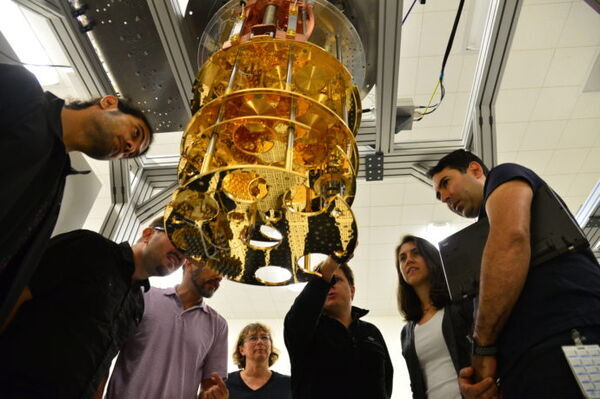
Intel Collaborates with Argonne National Laboratory, DOE in Q-NEXT Quantum Computing Research
" Intel today announced that it is among the leading U.S. quantum technology companies included in Q-NEXT, one of five new national quantum research centers established by the White House Office of Science and Technology Policy (OSTP) and the U.S. Department of Energy (DOE). Q-NEXT, National Quantum Information Science Research Center, is led by Argonne National Laboratory and brings together world-class researchers from national laboratories, universities and leading technology companies to ensure U.S. scientific and economic leadership in this advancing field. The collaboration will enable Intel to actively contribute to the industry’s efforts on quantum computing. “Advancing quantum practicality will be a team sport across the ecosystem, and our partnership with Argonne National Laboratory on Q-NEXT will enable us to bring our unique areas of expertise to this cross-industry effort to drive meaningful progress in the field. At Intel, we are taking a broad view of quantum research that spans hardware and software with a singular focus on getting quantum out of labs and into the real world, where it can solve real problems.” –James Clarke, director of Quantum Hardware at Intel Why It Matters: Quantum computing has the potential to tackle problems beyond the capabilities of conventional systems today by leveraging a phenomenon of quantum physics that exponentially expands computational power. This could dramatically speed complex problem-solving in a variety of fields such as pharmaceuticals, telecommunications and materials science, accelerating what today could take years to complete in only a matter of minutes." [...]

Safe Travels: Voyage Intros Ambulance-Grade, Self-Cleaning Driverless Vehicle Powered by NVIDIA DRIVE
"Self-driving cars continue to amaze passengers as a truly transformative technology. However, in the time of COVID-19, a self-cleaning car may be even more appealing. Robotaxi startup Voyage introduced its third-generation vehicle, the G3, this week. The autonomous vehicle, a Chrysler Pacifica Hybrid minivan retrofitted with self-driving technology, is the company’s first designed to operate without a driver and is equipped with an ambulance-grade ultraviolet light disinfectant system to keep passengers healthy. The new vehicles use the NVIDIA DRIVE AGX Pegasus compute platform to enable the startup’s self-driving AI for robust perception and planning. The automotive-grade platform delivers safety to the core of Voyage’s autonomous fleet." [...]
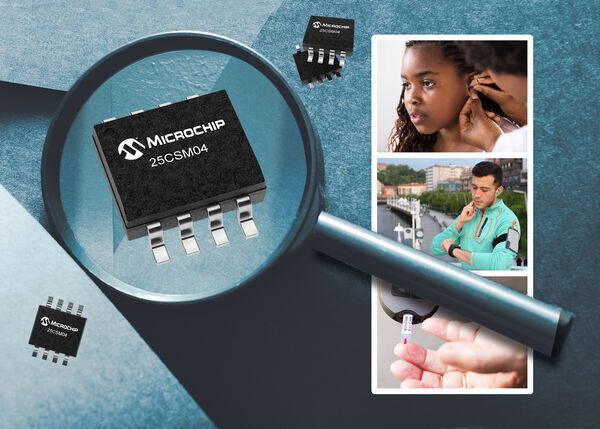
Microchip Introduces Its Highest-Density EEPROM with 4 Mbit Serial EEPROM Debut
"New 4 Mbit EEPROM memory device provides designers with flexibility and proven reliability. Portable consumer and medical devices including fitness trackers, hearing aids and glucose monitors as well as industrial, automotive and other systems often use customer-specific data sets to optimize the consumer experience. These nonvolatile data sets – including calibration constants, background conditions, user preferences and changing noise environments – often are adjusted by the end system or user a few bytes at a time. Serial Electrically Erasable Programmable Read-Only Memory (EEPROM) is the memory of choice for these applications providing nonvolatility, byte-level control, ease-of-use and low-power consumption. Microchip Technology Inc. (Nasdaq: MCHP) today announced its new, highest-density EEPROM – the 25CSM04. At 4 Mbit, Microchip’s new EEPROM becomes the largest EEPROM available to developers, doubling the 2 Mbit density designers previously were limited to." [...]

Toshiba’s New Photorelays Contribute to Equipment Downsizing by Reducing Mounting Density
"Toshiba Electronic Devices & Storage Corporation (“Toshiba”) has launched three photorelays: “TLP3407SRA,” “TLP3475SRHA” and “TLP3412SRHA,” that are the industry-smallest[1] voltage driven photorelays with an extended operating temperature rating of 125°C. Raising the maximum operating temperature rating from 110°C to 125°C allows the photorelays to be mounted in high temperature areas, and makes it easier to secure required temperature design margins for equipment. The S-VSON4T package has the industry-smallest[1] mounting area of 2.9mm² .This will contribute to reducing PCB size or to increasing the number of photorelays in an existing layout in applications such as semiconductor testers, probe cards and other devices. Applications - Semiconductor testers (memory, SoC and LSI, etc.) - Probe cards - Burn-in equipment - Measuring instruments (oscilloscope, data logger, etc.) Features - S-VSON4T, the industry’s first[1] packaging with a minimal mounting area and maximum operating temperature of 125°C: Mounting area 2.9mm2 (typ.)" [...]

Cellular IoT development board simplifies prototyping of space-constrained IoT products for makers and hobbyists
"Circuit Dojo’s Feather platform employs Nordic’s nRF9160 SiP to offer low power LTE-M/NB-IoT cellular IoT and GPS for global operation Nordic Semiconductor today announces that Circuit Dojo, a Branford, CT-based electronic design company, has selected Nordic’s nRF9160 low power System-in-Package (SiP) with integrated LTE-M/NB-IoT modem and GPS to power its open source ‘nRF9160 Feather’ development board. The development board is designed to simplify prototyping and speed time to market for makers, hobbyists, and developers of cellular IoT-based solutions. Functional and compact The nRF9160 Feather is supplied in a miniaturized 50.8 by 22.8mm form factor and incorporates much of the functionality of Nordic’s nRF9160 DK (Development Kit) but in a more compact size. The product enables users to start development using Nordic’s nRF Connect SDK (Software Development Kit) which includes application layer protocols, application examples, and LTE modem firmware offered as precertified and precompiled downloads. The SDK also incorporates the Zephyr real time operating system (RTOS) for constrained, energy-limited and secure IoT products. Development with nRF Connect SDK and nRF9160 Feather allows makers, hobbyists and hackers to build highly reliable, efficient, multi-threaded cellular IoT applications." [...]

STMicroelectronics Expands Access to Market-Unique LoRa®-Enabled STM32WL SoC with 48-Pin Package Option
"STMicroelectronics has added a QFN48 package to the award-winning STM32WLE5* wireless System-on-Chip (SoC) portfolio, bringing the device’s extensive feature integration, power efficiency, and multi-modulation flexibility to a wider variety of industrial wireless applications. The STM32WLE5, named ‘Best IoT Connectivity Solution’ at IoT World 2020, combines ST’s STM32L4 ultra-low-power microcontroller technology and Semtech SX126x sub-GHz radio IP optimized to meet local radio-equipment regulations worldwide. Its unique single-silicon-die integration helps save bill-of-materials (BOM) costs and simplifies the design of connected, smart devices for applications in metering, city management, agriculture, retail, logistics, smart buildings, and environmental management. Long-term availability is assured through ST’s rolling 10-year longevity commitment for industrial products. With its low power consumption and small footprint, the STM32WLE5 enables energy efficient, compact, and lightweight new products for burgeoning IoT markets. Now, the new 7mm x 7mm QFN48 package option makes it suited to a simplified two-layer board design that further eases manufacturing and reduces BOM costs." [...]
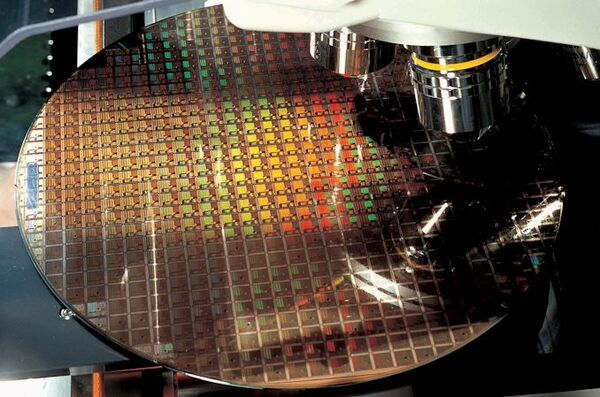
TSMC Details 3nm Process Technology: Full Node Scaling for 2H22 Volume Production
"At TSMC’s annual Technology Symposium, the Taiwanese semiconductor manufacturer detailed characteristics of its future 3nm process node as well as laying out a roadmap for 5nm successors in the form of N5P and N4 process nodes. Starting off with TSMC’s upcoming N5 process node which represents its 2nd generation deep-ultraviolet (DUV) and extreme-ultraviolet (EUV) process node after the rarely used N7+ node (Used by the Kirin 990 SoC for example). TSMC has been in mass production for several months now as we’re expecting silicon shipping to customers at this moment with consumer products shipping this year – Apple’s next-generation SoCs being the likely first candidates for the node. TSMC details that N5 currently is progressing with defect densities one quarter ahead of N7, with the new node having better yields at the time of mass production than both their predecessor major nodes N7 and N10, with a projected defect density that’s supposed to continue to improve past the historic trends of the last two generations. The foundry is preparing a new N5P node that’s based on the current N5 process that extends its performance and power efficiency with a 5% speed gain and a 10% power reduction. Beyond N5P, TSMC is also introducing the N4 node that represents a further evolution from the N5 process, employing further EUV layers to reduce masks, with minimal migration work required by chip designers." [...]
Ciência e Tecnologia

No More Playing with Fire: Study Offers Insight into “Safer” Rechargeable Batteries
"Lithium-ion batteries (LIBs) are a common type of rechargeable batteries. Their versatile nature and numerous applications in all sorts of electronic devices—from mobile phones to cars—makes them seem too good to be true. And perhaps they are: recently, there has been an increase in the number of fire-related incidents associated with LIBs, especially during charging, causing serious concerns over their safety. Scientists now know that these incidents can be due to the use of a broken or unauthorized charger. Often, improper use of these chargers and overcharging can lead to the formation of spiky structures on the negative electrode of the battery, called “lithium (Li) dendrites,” which penetrate through the barrier between the negative and positive electrodes and cause a short circuit. Thus, looking at exactly how dendrite formation occurs is crucial to improving the safety of LIBs." [...]

Picking Locks with Audio Technology
"The next time you unlock your front door, it might be worth trying to insert your key as quietly as possible; researchers have discovered that the sound of your key being inserted into the lock gives attackers all they need to make a working copy of your front door key. It sounds unlikely, but security researchers say they have proven that the series of audible, metallic clicks made as a key penetrates a lock can now be deciphered by signal processing software to reveal the precise shape of the sequence of ridges on the key's shaft. Knowing this (the actual cut of your key), a working copy of it can then be three-dimensionally (3D) printed. This discovery of a major vulnerability in the physical keys that millions of us use to secure domestic and workplace doors and lockers was made by cyberphysical systems researcher Soundarya Ramesh and her team at the National University of Singapore. At the 21st International Workshop on Mobile Computing Systems and Applications (HotMobile 2020) in Austin, TX, in early March, Ramesh revealed how their technique works. What's being attacked by the NUS team are the keys to pin-tumbler locks, best known as Yale or Schlage keys, though those are just the market leaders and a whole host of other firms make them, too." [...]
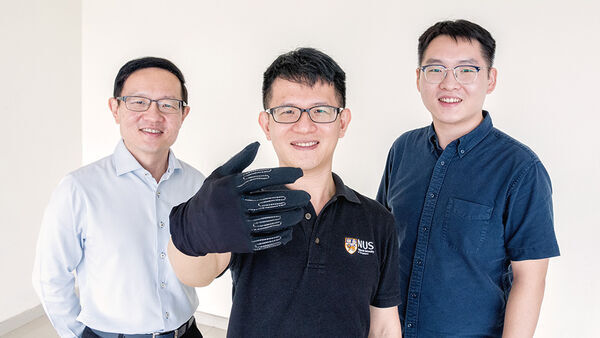
NUS researchers develop new smart gaming glove
"Simply flex your index finger to fire your weapon and rotate your wrist clockwise to move forward. Immersive controls have always been a pipedream in the world of gaming, but is steadily becoming reality. A team of researchers from NUS, led by Professor Lim Chwee Teck, has developed a smart glove – called ‘InfinityGlove™’ – that allows users to mimic a variety of in-game controls using simple hand gestures. While the concept of controlling a game using your hands is not new, the main problems have always been weight and flexibility. The current generation of smart glove type controllers available on the market are usually bulky and rigid as they rely on conventional sensors which put the hard in hardware. The InfinityGlove™, overcomes existing problems with weight and flexibility by weaving ultra-thin, highly sensitive microfibre sensors into the material of the glove." [...]
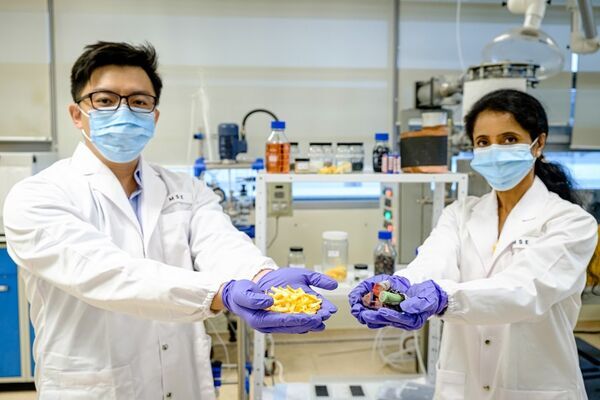
NTU Singapore scientists use fruit peel to turn old batteries into new
"Scientists led by Nanyang Technological University, Singapore (NTU Singapore) have developed a novel method of using fruit peel waste to extract and reuse precious metals from spent lithium-ion batteries in order to create new batteries. The team demonstrated their concept using orange peel, which recovered precious metals from battery waste efficiently. They then made functional batteries from these recovered metals, creating minimal waste in the process. The scientists say that their waste-to-resource approach tackles both food waste and electronics waste, supporting the development of a circular economy with zero waste, in which resources are kept in use for as long as possible. An estimated 1.3 billion tonnes of food waste and 50 million tonnes of e-waste are generated globally each year. Spent batteries are conventionally treated with extreme heat (over 500°C) to smelt valuable metals, which emits hazardous toxic gases." [...]
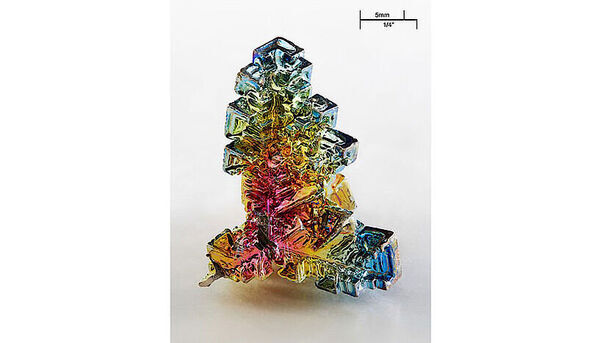
Quantum Simulation of Quantum Crystals
"International research team describes the new possibilities offered by the use of ultracold dipolar atoms The quantum properties underlying crystal formation can be replicated and investigated with the help of ultracold atoms. A team led by Dr. Axel U. J. Lode from the University of Freiburg’s Institute of Physics has now described in the journal Physical Review Letters how the use of dipolar atoms enables even the realization and precise measurement of structures that have not yet been observed in any material. The theoretical study was a collaboration involving scientists from the University of Freiburg, the University of Vienna and the Technical University of Vienna in Austria, and the Indian Institute of Technology in Kanpur, India. Crystals are ubiquitous in nature. They are formed by many different materials – from mineral salts to heavy metals like bismuth. Their structures emerge because a particular regular ordering of atoms or molecules is favorable, because it requires the smallest amount of energy." [...]

Cosmic rays may soon stymie quantum computing
"Building quantum computers underground or designing radiation-proof qubits may be needed, researchers find. The practicality of quantum computing hangs on the integrity of the quantum bit, or qubit. Qubits, the logic elements of quantum computers, are coherent two-level systems that represent quantum information. Each qubit has the strange ability to be in a quantum superposition, carrying aspects of both states simultaneously, enabling a quantum version of parallel computation. Quantum computers, if they can be scaled to accommodate many qubits on one processor, could be dizzyingly faster, and able to handle far more complex problems, than today’s conventional computers. But that all depends on a qubit’s integrity, or how long it can operate before its superposition and the quantum information are lost — a process called decoherence, which ultimately limits the computer run-time." [...]
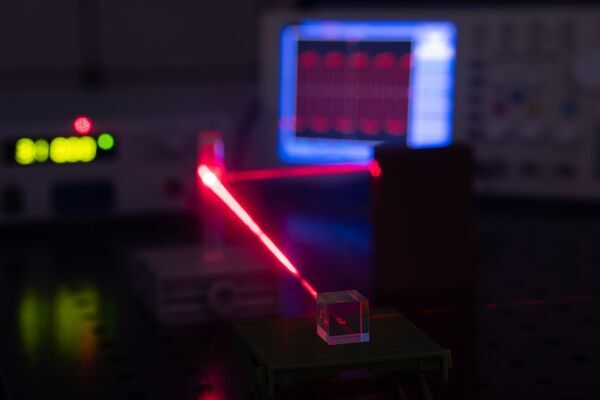
Army scientists take new spin on quantum research
"Army researchers discovered a way to further enhance quantum systems to provide Soldiers with more reliable and secure capabilities on the battlefield. Specifically, this research informs how future quantum networks will be designed to deal with the effects of noise and decoherence, or the loss of information from a quantum system in the environment. As one of the U.S. Army’s priority research areas in its Modernization Strategy, quantum research will help transform the service into a multi-domain force by 2035 and deliver on its enduring responsibility as part of the joint force providing for the defense of the United States. “Quantum networking, and quantum information science as a whole, will potentially lead to unsurpassed capabilities in computation, communication and sensing,” said Dr. Brian Kirby, researcher at the U.S. Army Combat Capabilities Development Command’s Army Research Laboratory. “Example applications of Army interest include secure secret sharing, distributed network sensing and efficient decision making.” This research effort considers how dispersion, a very common effect found in optical systems, impacts quantum states of three or more particles of light. Dispersion is an effect where a pulse of light spreads out in time as it is transmitted through a medium, such as a fiber optic." [...]

Nanodots made of photovoltaic material support waveguide modes
"New spectroscopic technique for studying nanostructures demonstrates that stibnite nanodots can act as high-optical-quality waveguides and are promising candidates as photoswitchable materials for future applications Antimony sulfide, or stibnite (Sb2S3), has been investigated intensively in recent years as a promising material for nontoxic, environmentally friendly solar cells. It is now possible to fabricate thin photovoltaic films from an ink containing nanoparticles of stibnite, and to nanopattern those films for 2D and 3D structures of pretty much any shape. Such simple, cost-effective production methods fulfill prerequisites for reliable, widespread use. Since stibnite is an effective semiconductor (i.e., it has a high absorption coefficient and carrier mobility), its nanostructure holds promise as a photoswitchable material for all-optical signal processing and computing. Petra Groß, researcher at the Institute for Physics at University of Oldenburg explains, "Illumination with near-infrared light, with wavelengths for which stibnite is largely transparent, can result in an ultrafast change of its refractive index. This means that a surface patterned with stibnite nanoparticles could enable optical properties like reflection of color appearance to be switched by an infrared light pulse."" [...]
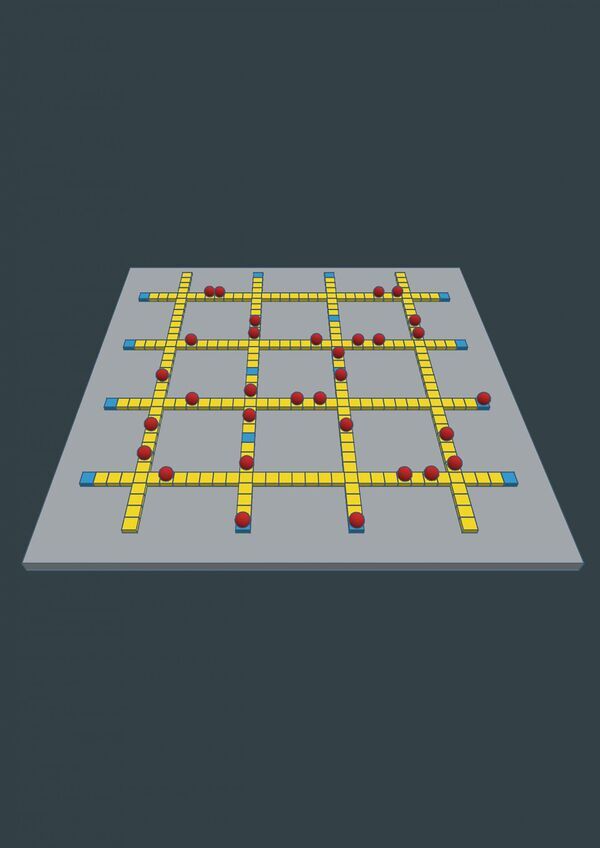
Sussex study enables predicting computational power of early quantum computers
"Quantum physicists at the University of Sussex have created an algorithm that speeds up the rate of calculations in the early quantum computers which are currently being developed. They have created a new way to route the ions – or charged atoms – around the quantum computer to boost the efficiency of the calculations. The Sussex team have shown how calculations in such a quantum computer can be done most efficiently, by using their new ‘routing algorithm’. Their paper “Efficient Qubit Routing for a Globally Connected Trapped Ion Quantum Computer” is published in the journal Advanced Quantum Technologies. The team working on this project was led by Professor Winfried Hensinger and included Mark Webber, Dr Steven Herbert and Dr Sebastian Weidt. The scientists have created a new algorithm which regulates traffic within the quantum computer just like managing traffic in a busy city." [...]

New tech extracts potential to identify quality graphene cheaper and faster
"Engineers from Monash University have created world-first technology that can help industry identify high quality graphene cheaper, faster and more accurately than current methods. Researchers have created a machine-learning algorithm that can characterise graphene properties and quality within 14 minutes. Graphene is a highly valued commodity, derived from graphite. It has numerous properties that make it an appealing candidate for applications such as energy storage, filtration, and sensing. Engineers at Australia’s Monash University have developed world-first technology that can help industry identify and export high quality graphene cheaper, faster and more accurately than current methods. Published today in international journal Advanced Science, researchers used the data set of an optical microscope to develop a machine-learning algorithm that can characterise graphene properties and quality, without bias, within 14 minutes." [...]
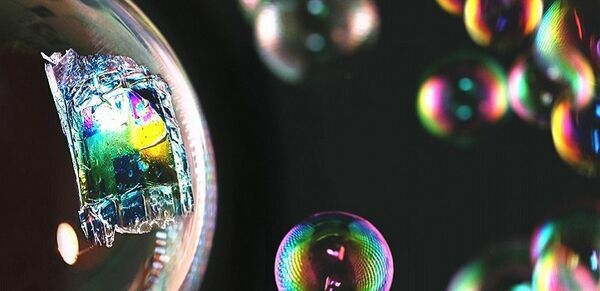
Thin-skinned solar panels printed with inkjet
"Solar cells can now be made so thin, light and flexible that they can rest on a soap bubble. The new cells, which efficiently capture energy from light, could offer an alternative way to power novel electronic devices, such as medical skin patches, where conventional energy sources are unsuitable. “The tremendous developments in electronic skin for robots, sensors for flying devices and biosensors to detect illness are all limited in terms of energy sources,” says Eloïse Bihar, a postdoc in the team of Derya Baran, who led the research. “Rather than bulky batteries or a connection to an electrical grid, we thought of using lightweight, ultrathin organic solar cells to harvest energy from light, whether indoors or outdoors.” Until now, ultrathin organic solar cells were typically made by spin-coating or thermal evaporation, which are not scalable and which limit device geometry. This technique involved using a transparent and conductive, but brittle and inflexible, material called indium tin oxide (ITO) as an electrode. To overcome these limitations, the team applied inkjet printing." [...]
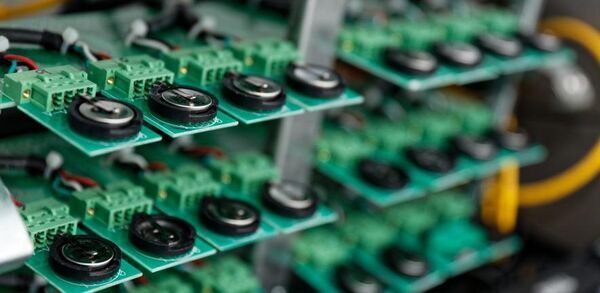
New insights into lithium-ion battery failure mechanism
"Researchers have identified a potential new degradation mechanism for electric vehicle batteries – a key step to designing effective methods to improve battery lifespan. The researchers, from the Universities of Cambridge and Liverpool, and the Diamond Light Source, have identified one of the reasons why state-of-the-art ‘nickel-rich’ battery materials become fatigued, and can no longer be fully charged after prolonged use. Their results, reported in the journal Nature Materials, open the door to the development of new strategies to improve battery lifespans. As part of efforts to combat climate change, many countries have announced ambitious plans to replace petrol or diesel vehicles with electric vehicles (EVs) by 2050 or earlier. The lithium-ion batteries used by EVs are likely to dominate the EV market for the foreseeable future, and nickel-rich lithium transition-metal oxides are the state-of-the-art choice for the positive electrode, or cathode, in these batteries. Currently, most EV batteries contain significant amounts of cobalt in their cathode materials." [...]

Researchers on a Path to Build Powerful and Practical Quantum Computer
"Carefully optimized subsystems used to build a 32-qubit trapped-ion register for quantum computation. For the first time, researchers have designed a fully connected 32-qubit trapped-ion quantum computer register operating at cryogenic temperatures. The new system represents an important step toward developing practical quantum computers. Junki Kim from Duke University will present the new hardware design at the inaugural OSA Quantum 2.0 conference to be co-located as an all-virtual event with OSA Frontiers in Optics and Laser Science APS/DLS (FiO + LS) conference 14 – 17 September. Instead of using traditional computer bits that can only be a zero or a one, quantum computers use qubits that can be in a superposition of computational states. This allows quantum computers to solve problems that are too complex for traditional computers." [...]

Transparent near-infrared light-emitting diodes
"NUS researchers have developed transparent near-infrared light-emitting diodes (LEDs) that could be integrated into the displays of smart-watches, smart-phones and augmented or virtual reality devices. Near-infrared (NIR) covert illumination is increasingly important for facial recognition, motion sensing and depth sensing functions in mobile devices. However, these NIR illumination sources, which are usually non–transparent LED chips, occupy valuable space and could lead to unsightly black notches on an otherwise full-area colour display. A research team led by Prof TAN Zhi Kuang from the Department of Chemistry and the Solar Energy Research Institute of Singapore (SERIS), NUS has developed efficient NIR LEDs that are highly-transparent, with an average transmittance of more than 55% across the visible spectrum. Their devices employ an ultra-thin layer of a novel perovskite-based semiconductor, which is capable of intense and efficient light emission. This perovskite semiconductor also benefits from low-cost processing and versatile integration into a variety of device substrates." [...]
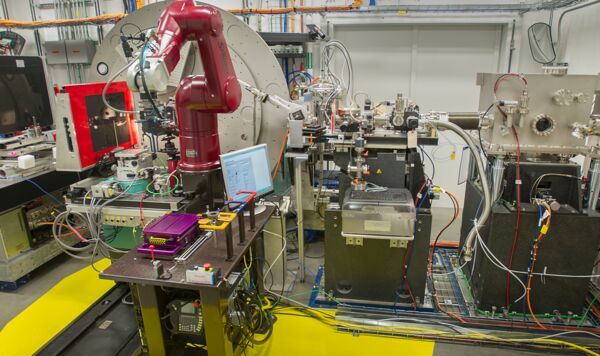
Microwaving new materials
"Reeja Jayan has made a breakthrough in our understanding of how microwaves affect materials chemistry, laying the groundwork for tailor-made ceramic materials with new electronic, thermal, and mechanical properties. Microwave ovens are the mainstay of cooking appliances in our homes. Five years ago, when Reeja Jayan was a new professor at Carnegie Mellon University, she was intrigued by the idea of using microwaves to grow materials. She and other researchers had shown that microwave radiation enabled temperature crystallization and growth of ceramic oxides. Exactly how microwaves did this was not well understood, and this mystery inspired Jayan to reengineer a $30 microwave oven so she could investigate the dynamics effects of microwave radiation on the growth of materials. Today, Jayan, who is now an associate professor of mechanical engineeringOpens in new window, has made a breakthrough in our understanding of how microwaves affect materials chemistry." [...]

Photonics researchers report breakthrough in miniaturizing light-based chips
"Rochester team demonstrates new way to control light as it moves through integrated circuits, paving a research avenue in communications, computing, and photonics research. Photonic integrated circuits that use light instead of electricity for computing and signal processing promise greater speed, increased bandwidth, and greater energy efficiency than traditional circuits using electricity. But they’re not yet small enough to compete in computing and other applications where electric circuits continue to reign. Electrical engineers at the University of Rochester believe they’ve taken a major step in addressing the problem. Using a material widely adopted by photonics researchers, the Rochester team has created the smallest electro-optical modulator yet. The modulator is a key component of a photonics-based chip, controlling how light moves through its circuits." [...]

A new lens on the world
"Case Western Reserve scientists, collaborators at Harvard and Italian university Unical, aim to ‘revolutionize optics’ by combining nanostructured metasurfaces with liquid crystal technology For more than 500 years, humans have mastered the art of refracting light by shaping glass into lenses, then bending or combining those lenses to amplify and clarify images either close up or far away. But in the last decade or so, a group led by scientist Federico Capasso at Harvard University has begun to transform the field of optics by engineering flat optics metasurfaces, employing an array of millions of tiny microscopically thin and transparent quartz pillars to diffract and mold the flow of light in much the same way as a glass lens, but without the aberrations that naturally limit the glass. The technology was selected as among the Top 10 Emerging Technologies by the World Economic Forum (WEF) in 2019, which remarked that these increasingly smaller, clearer lenses would soon begin to be seen in camera phones, sensors, optical-fiber lines and medical-imaging devices, such as endoscopes. “Making the lenses used by mobile phones, computers and other electronic devices smaller has been beyond the capabilities of traditional glass cutting and glass curving techniques,” according to the WEF. “…These tiny, thin, flat lenses could replace existing bulky glass lenses and allow further miniaturization in sensors and medical imaging devices.” Making metalenses ‘reconfigurable’ Now, Case Western Reserve University physics professor Giuseppe Strangi and collaborators at Harvard have taken a step toward making these “metalenses” even more useful—by making them reconfigurable. They did this by harnessing nanoscale forces to infiltrate liquid crystals between those microscopic pillars, allowing them to shape and diffract the light in completely new ways—“tuning” the focusing power, Strangi said." [...]
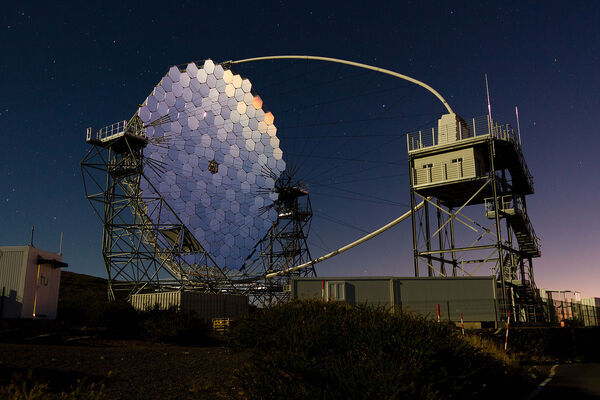
Neural networks show potential for identifying gamma rays detected by Cherenkov Telescope Array
"With the Cherenkov Telescope Array (CTA) that is currently under construction, researchers hope to observe highly energetic gamma rays that could lead to the discovery of new objects in and outside of our galaxy and even unravel the mystery of dark matter. However, identifying these gamma rays is not easy. Researchers from the CTA consortium are now trying to perfect it with neural networks trained on the “Piz Daint” supercomputer. Upon completion in 2025, the Cherenkov Telescope Array (CTA) will be the largest gamma-ray observation telescope array ever built. More than 100 telescopes with diameters between 4 and 23 metres are being installed in the northern and southern hemispheres, at the Roque de los Muchachos Observatory on the Canary Island La Palma and in the Atacama Desert in Chile. The telescopes are designed to comprehensively record flashes of light induced by the gamma rays travelling through the cosmos that strike the Earth's atmosphere." [...]

Researchers develop flat lens a thousand times thinner than a human hair
"By José Tadeu Arantes | Agência FAPESP – A lens that is a thousand times thinner than a human hair has been developed in Brazil by researchers at the University of São Paulo’s São Carlos School of Engineering (EESC-USP). It can serve as a camera lens in smartphones or be used in other devices that depend on sensors. “In the present technological context, its applications are almost unlimited,” Emiliano Rezende Martins, a professor in EESC-USP’s Department of Electrical Engineering and Computing and last author of a published paper on the invention, told Agência FAPESP. The paper is entitled “On Metalenses with Arbitrarily Wide Field of View” and is published in ACS Photonics. The study was supported by FAPESP via a scholarship for a research internship abroad awarded to Augusto Martins, PhD candidate and lead author of the paper. The lens consists of a single nanometric layer of silicon on arrays of nanoposts that interact with light." [...]
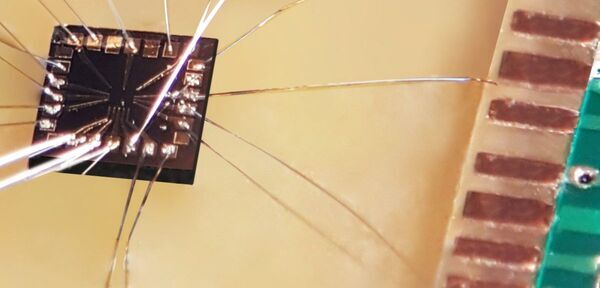
AI automatic tuning delivers step forward in Quantum computing
"Researchers at Oxford University, in collaboration with DeepMind, University of Basel and Lancaster University, have created a machine learning algorithm that interfaces with a quantum device and ‘tunes’ it faster than human experts, without any human input. They are dubbing it ‘Minecraft explorer for quantum devices’. Classical computers are composed of billions of transistors, which together can perform complex calculations. Small imperfections in these transistors arise during manufacturing, but do not usually affect the operation of the computer. However, in a quantum computer similar imperfections can strongly affect its behaviour. In prototype semiconductor quantum computers, the standard way to correct these imperfections is by adjusting input voltages to cancel them out." [...]

Observing ancient neutrinos
"Super-Kamiokande gets an upgrade to see neutrinos from ancient supernovae The Super-Kamiokande neutrino observatory can detect different kinds of neutrino-related phenomena, including supernova explosions in our own galaxy. It is normally full of pure water, but it has recently received a dose of the rare-earth element gadolinium. This will give the observatory the ability to see supernova explosions in more distant galaxies as well. Buried 1 kilometer underground near the city of Hida in central Japan is an enormous cylinder 40 meters tall and filled with 50 million liters of water. This is the Super-Kamiokande neutrino observatory, and since 1996 it has been observing neutrinos, subatomic particles, from solar, extrasolar, terrestrial and artificial sources. It detects these particles with highly sensitive optical sensors which record minute flashes of light that occur when a neutrino interacts with a molecule of water." [...]
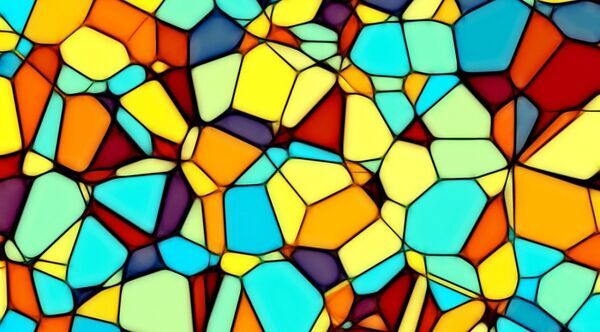
Quantum Computers Do the (Instantaneous) Twist
"Regardless of what makes up the innards of a quantum computer, its speedy calculations all boil down to sequences of simple instructions applied to qubits—the basic units of information inside a quantum computer. Whether that computer is built from chains of ions, junctions of superconductors, or silicon chips, it turns out that a handful of simple operations, which affect only one or two qubits at a time, can mix and match to create any quantum computer program—a feature that makes a particular handful “universal.” Scientists call these simple operations quantum gates, and they have spent years optimizing the way that gates fit together. They’ve slashed the number of gates (and qubits) required for a given computation and discovered how to do it all while ensuring that errors don’t creep in and cause a failure. Now, researchers at JQI have discovered ways to implement robust, error-resistant gates using just a constant number of simple building blocks—achieving essentially the best reduction possible in a parameter called circuit depth. Their findings, which apply to quantum computers based on topological quantum error correcting codes, were reported in two papers published recently in the journals Physical Review Letters(link is external) and Physical Review B(link is external), and expanded on in a third paper published earlier in the journal Quantum(link is external). Circuit depth counts the number of gates that affect each qubit, and a constant depth means that the number of gates needed for a given operation won’t increase as the computer grows—a necessity if errors are to be kept at bay." [...]
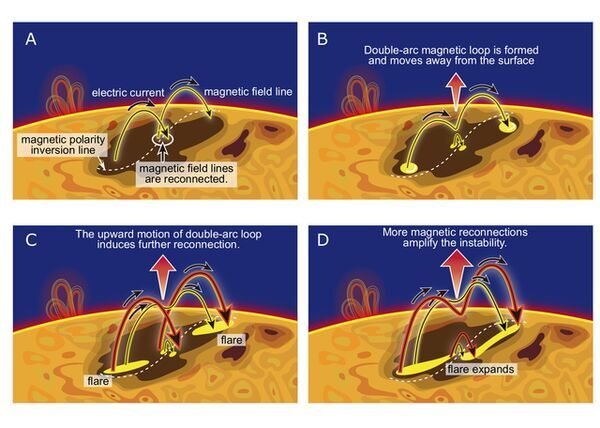
Research team develops the first physics-based method for predicting large solar flares
"Solar flares emit sudden, strong bursts of electromagnetic radiation from the Sun's surface and its atmosphere, and eject plasma and energetic particles into inter-planetary space. Since large solar flares can cause severe space weather disturbances affecting Earth, to mitigate their impact their occurrence needs to be predicted. However, as the onset mechanism of solar flares is unclear, most flare prediction methods so far have relied on empirical methods. The research team led by Professor Kanya Kusano (Director of the Institute for Space-Earth Environmental Research, Nagoya University) recently succeeded in developing the first physics-based model that can accurately predict imminent large solar flares. The work was published in the journal Science on July 31, 2020. The new method of flare prediction, called the kappa scheme, is based on the theory of "double-arc instability," that is a magnetohydrodynamic (MHD) instability triggered by magnetic reconnection." [...]

A Four-State Magnetic Tunnel Junction for Novel Spintronics Applications
"A novel magnetic tunnel junction, which has four resistance states instead of two states in existing magnetic tunnel junctions, may pave the way to novel spintronics devices, including multi-level magnetic memory. A tunnel junction is a device consisting of two conducting layers separated by an insulating layer. Classically, the resistance for driving current across an insulating layer is infinite; however, when the insulating layer is thin (~ 1-2 nanometers), charge carriers may tunnel through the insulating layer, due to their quantum nature. When the conducting layers are magnetic, a magnetic tunnel junction (MTJ), whose resistance depends on the magnetic configurations, is obtained. Current MTJs have only two resistance states as they support either parallel or anti-parallel magnetic configurations of the two magnetic layers. The two-state MTJ has been playing a central role in spintronics, a branch of electronics that uses the magnetic moment associated with the spin of the electron in addition to the electron charge used in traditional electronics." [...]
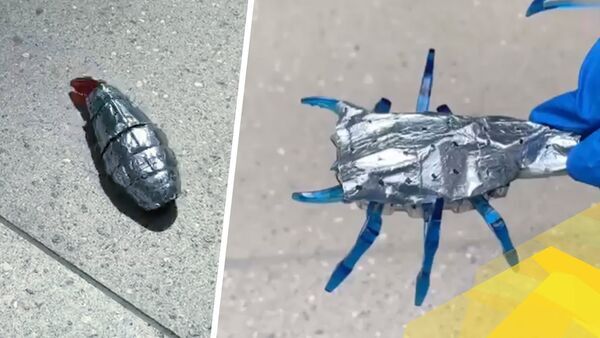
Biomorphic batteries could provide 72x more energy for robots
"Like biological fat reserves store energy in animals, a new rechargeable zinc battery integrates into the structure of a robot to provide much more energy, a team led by the University of Michigan has shown. This approach to increasing capacity will be particularly important as robots shrink to the microscale and below—scales at which current stand-alone batteries are too big and inefficient. “Robot designs are restricted by the need for batteries that often occupy 20% or more of the available space inside a robot, or account for a similar proportion of the robot’s weight,” said Nicholas Kotov, the Joseph B. and Florence V. Cejka Professor of Engineering, who led the research. Applications for mobile robots are exploding, from delivery drones and bike-lane take-out bots to robotic nurses and warehouse robots. On the micro side, researchers are exploring swarm robots that can self-assemble into larger devices. Multifunctional structural batteries can potentially free up space and reduce weight, but until now they could only supplement the main battery." [...]
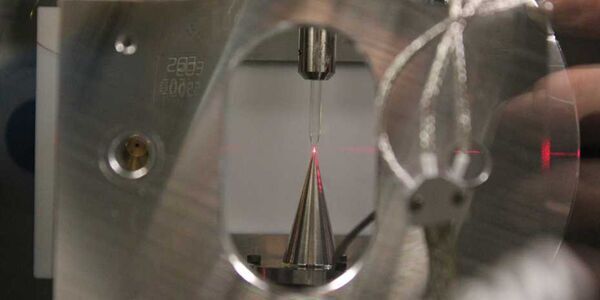
Electron movements in liquid measured in super-slow motion
"Electrons are able to move within molecules, for example when they are excited from outside or in the course of a chemical reaction. For the first time, scientists have now succeeded in studying the first few dozen attoseconds of this electron movement in a liquid. To understand how chemical reactions begin, chemists have been using super-slow motion experiments for years to study the very first moments of a reaction. These days, measurements with a resolution of a few dozen attoseconds are possible. An attosecond is 1x10-18 of a second, i.e. a millionth of a millionth of a millionth of a second." [...]

Plasma guides maintain focus of lasers
"In science fiction, firing powerful lasers looks easy -- the Death Star can just send destructive power hurtling through space as a tight beam. But in reality, once a powerful laser has been fired, care must be taken to ensure it doesn't get spread too thin. If you've ever pointed a flashlight at a wall, you've observed an example of the diffusion of light. The farther you are from the wall, the more the beam spreads, resulting in a larger and dimmer spot of light. Lasers generally expand much more slowly than the beams from flashlights, but the effect of diffusion is important when the laser travels a long way or must maintain a high intensity. Whether your goal is to achieve galactic domination or, more realistically, to accelerate electrons to incredible speeds for physics research, you'll want as tight and powerful a beam as possible to maximize the intensity." [...]
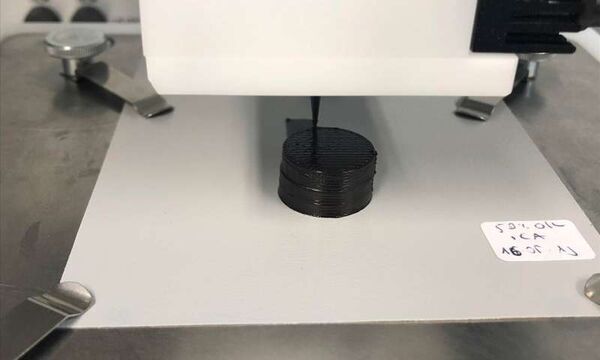
From Biopaste to Bioplastic
"A viscous biopaste that is easy to process, solidifies quickly and is suitable for producing even complex structures using the 3D printing process has been developed by a research team headed by Prof. Dr. Marie-Pierre Laborie from the Chair of Forest Biomaterials at the University of Freiburg. The wood-based biodegradable synthetic could potentially be used in lightweight construction, amongst other things. The scientists have published their initial results in the journals Applied Bio Materials and Biomacromolecules. Lignin strengthens the cell walls of plants and causes them to turn woody (lignify) – a mechanism that helps plants to protect themselves against wind or pests. It is a waste product from paper manufacture and largely incinerated to produce bioenergy. “This is why we’re researching into alternative possibilities for making better use of this raw material in future,” says Laborie." [...]

Simulations, high-speed videos help researchers see crack formation in 3D-printed tungsten in real time
"Boasting the highest melting and boiling points of all known elements, tungsten has become a popular choice for applications involving extreme temperatures, including lightbulb filaments, arc welding, radiation shielding and, more recently, as plasma-facing material in fusion reactors such as the ITER Tokamak. However, tungsten’s inherent brittleness, and the microcracking that occurs while additively manufacturing (3D printing) with the rare metal, has hampered its widespread adoption. To characterize how and why these microcracks form, Lawrence Livermore National Laboratory (LLNL) scientists have combined thermomechanical simulations with high-speed videos taken during the laser powder-bed fusion (LPBF) metal 3D printing process. Whereas previous research was limited to examining cracks post-build, scientists for the first time were able to visualize the ductile-to-brittle transition (DBT) in tungsten in real-time, allowing them to observe how microcracks initiated and spread as the metal heated and cooled. The team was able to correlate the microcracking phenomenon with variables such as residual stress, strain rate and temperature, and confirm the DBT caused the cracking. Researchers said the study, recently published in the journal Acta Materialia and featured in the September issue of the prestigious MRS Bulletin, uncovers the fundamental mechanisms behind cracking in 3D-printed tungsten and sets a baseline for future efforts to produce crack-free parts from the metal." [...]
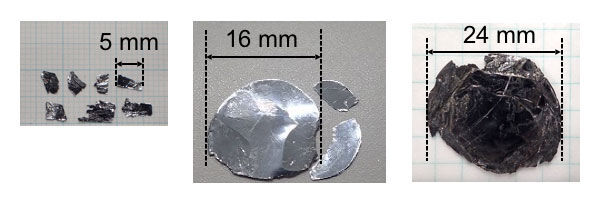
Large Tin Monosulfide Crystal Opens Pathway for Next Generation Solar Cells
"Tin monosulfide (SnS) is a promising material used for next generation solar cells because of its nontoxic characteristics and abundance, in addition to its excellent photovoltaic properties. Sakiko Kawanishi and Issei Suzuki led a team that has succeeded in growing large single crystals of SnS, which can provide a pathway for the fabrication of SnS solar cells with a high conversion efficiency. A p-n homojunction, which consists of p-type and n-type SnS, is key to obtaining SnS solar cells with high efficiency. The manufacturing of such solar cells has until now proved difficult due to the complexity of fabricating n-type SnS in contrast to the easily fabricable p-type SnS. SnS crystals grown by flux growth technique. Large single crystals were obtained by halogen addition to the flux." [...]
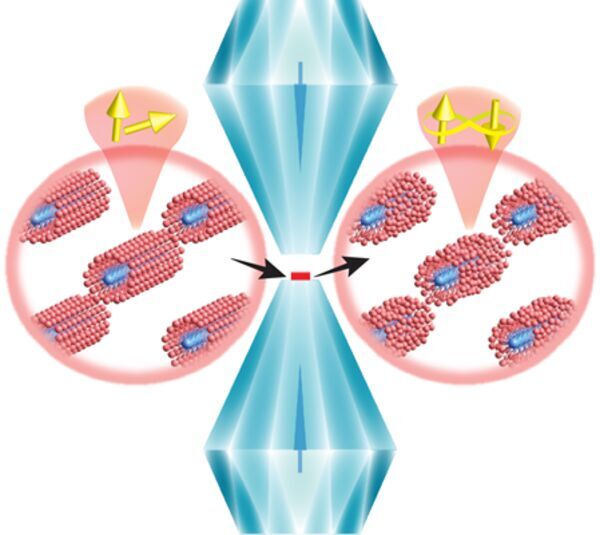
Researchers Discover Superconductor with Unexpected Lattice Configuration
"An international team discovered that compressing monocrystalline (TaSe4)2I can create a system where the constituent TaSe4Q1D atomic chains are in amorphous state without breaking the orientational and periodic translation symmetries of the chain lattice. Moreover, they found that along with the amorphization of the atomic chains, the insulating (TaSe4)2I becomes a superconductor. The team is led by Prof. YANG Zhaorong from the High Magnetic Field Laboratory, Hefei Institutes of Physical Science and Prof. ZHANG Gufei from University of Southern Denmark. In this study, they used monocrystalline (TaSe4)2I as the starting material for the realization of a new quasi-1D phase with advanced electronic properties. When increasing the applied pressure up to ca. 20 GPa, they realized the amorphization of the constituent atomic chains of (TaSe4)2I without breaking the long-range order of the chain lattice." [...]
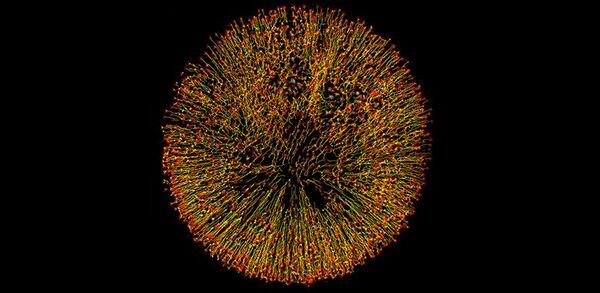
Coffee stains inspire optimal printing technique for electronics
"Using an alcohol mixture, researchers modified how ink droplets dry, enabling cheap industrial-scale printing of electronic devices at unprecedented scales. Have you ever spilled your coffee on your desk? You may then have observed one of the most puzzling phenomena of fluid mechanics – the coffee ring effect. This effect has hindered the industrial deployment of functional inks with graphene, 2D materials, and nanoparticles because it makes printed electronic devices behave irregularly. Now, after studying this process for years, a team of researchers have created a new family of inks that overcomes this problem, enabling the fabrication of new electronics such as sensors, light detectors, batteries and solar cells. Coffee rings form because the liquid evaporates quicker at the edges, causing an accumulation of solid particles that results in the characteristic dark ring." [...]
Documentação
A documentação é parte essencial do processo de aprendizagem e a Internet além de artigos interessantes de explorar também tem alguma documentação em formato PDF interessante de ler. Todos os links aqui apresentados são para conteúdo disponibilizado livremente pelo editor do livro.
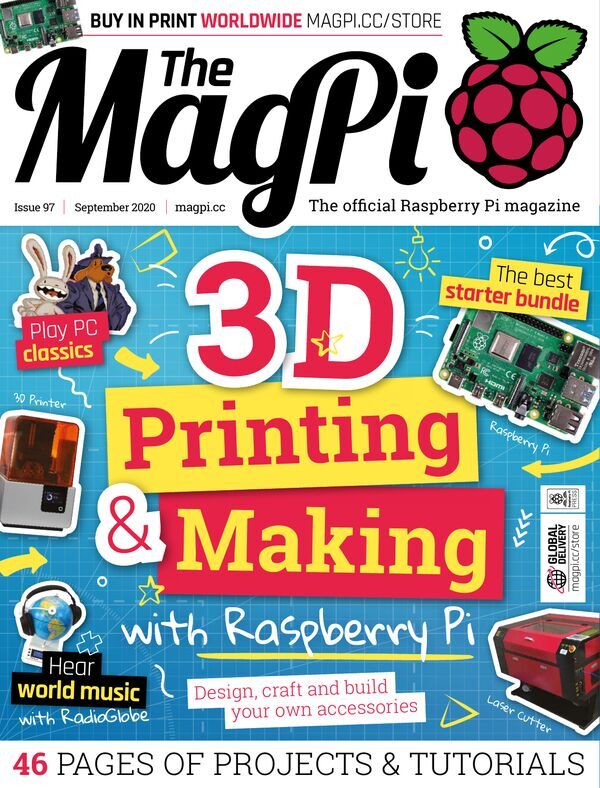
The MagPI 97
"3D Printing & Making in The MagPi 97. Discover 3D printing, laser cutting, and crafting techniques and make your own Raspberry Pi kit. Inside The MagPi magazine #97 3D Printing & Making. Design, craft, and build your own Raspberry Pi accessories. DOSBox-X legal game emulation. Use GOG, innoextract, DOSBox, and ScummVM to buy, extract, and run PC gaming classics on Raspberry Pi, from Zork to Blade Runner." [...]
Projetos Maker
Diversos Projetos interessantes.

Refrigerator Magnet Clock
"I've always been fascinated by unusual clocks. This is one of my latest creations that uses refrigerator alphabet numbers to display the time. The numbers are placed on a piece of thin white Plexiglas that has thin sheet metal laminated to the back. There are small magnets in each of the numbers that cause the number to cling to the sheet metal when they are not being moved. The numbers are moved using CoreXY mechanism that moves a carriage behind a number, it then engages two magnets which attract the magnets on the number and allows the number to follow the carriage movement. Once at it's destination the carriage magnets are disengaged and the number will stay in place because of the thin sheet metal backing the Plexiglas." [...]
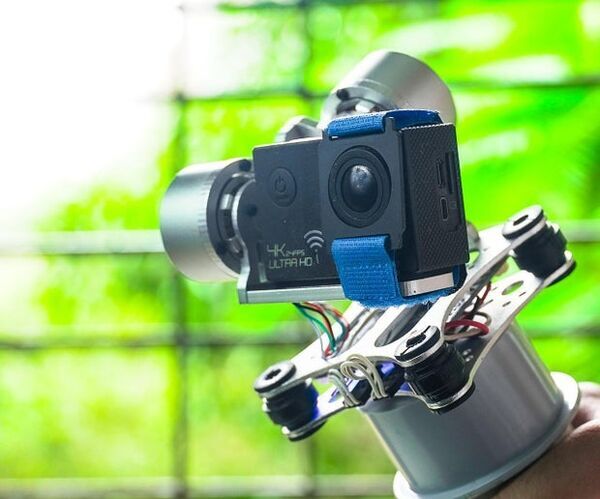
How to Make a Gimbal
"In todays culture we all love recording video and capturing the moments, especially when you are a content creator like me, you sure have faced the issue of such shaky videos from time to time. So in this blog we will make a DIY version of motorized Gimbal under $30, which will help you achieve stable videos on action cameras, so lets get started! A camera stabilizer, or camera–stabilizing mount, is a device designed to hold a camera in a manner that prevents or compensates for unwanted camera movement, which is more commonly known as camera shake. we will make a 2 axis gimbal for our Gopro / Action camera. we will the following parts: 2 axis FPV BGC Gimbal assembly. 3 Lithium Ion Cells." [...]
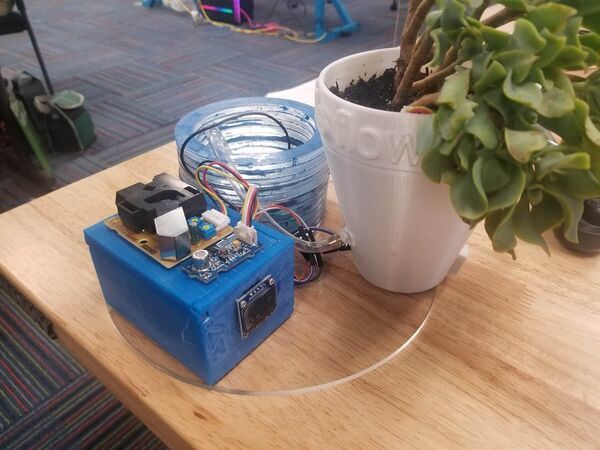
Smart Flower Pot
"A smart watering system that automatically waters a plant. Story For this project, we had to include a set of components we had needed to include: The BME280, Seeed Grove Dust sensor, Seeed Grove air quality v1.3 sensor, Capactive soil moisture sensor, Adafruit 128x64 oled display, a relay, and a particle argon. For my design, I wanted a setup that was clean-looking and more refined. I had wanted a box and flower pot setup that sat on a reservoir but ended up changing that to everything resting on a circular disc of acrylic. For the box, I modeled it and the lid in Autodesk fusion 360 and printed them out with the Formlabs 3 Resin printer. For the flowerpot i, I had modeled it in Fusion 360, too, and printed it out with the Ultimaker 3 3D printer." [...]
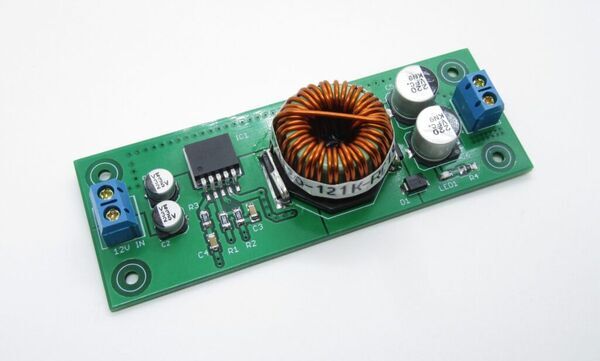
12V to 24V @ 1A Step-up switching regulator using LM2585
"This is a DC-DC step-up converter based on LM2585-ADJ regulator manufactured by Texas Instruments. This IC was chosen for its simplicity of use, requiring minimal external components and for its ability to control the output voltage by defining the feedback resistors (R1,R2). NPN switching/power transistor is integrated inside the regulator and is able to withstand 3A maximum current and 65V maximum voltage. Switching frequency is defined by internal oscillator and it’s fixed at 100KHz. The power switch is a 3-A NPN device that can standoff 65 V. Protecting the power switch are current and thermal limiting circuits and an under-voltage lockout circuit. This IC contains a 100-kHz fixed-frequency internal oscillator that permits the use of small magnetics." [...]

Reverse-engineering the 8086's Arithmetic/Logic Unit from die photos
"The Intel 8086 processor was introduced in 1978, setting the course of modern computing. While the x86 processor family has supported 64-bit processing for decades, the original 8086 was a 16-bit processor. As such, it has a 16-bit arithmetic logic unit (ALU).1 The arithmetic logic unit is the heart of a processor: it performs arithmetic operations such as addition and subtraction. It also carries out Boolean logic operations such as bitwise AND and OR as well as also bit shifts and rotates. Since a fast ALU is essential to the overall performance of a processor, ALUs often incorporate interesting design tricks. The die photo below shows the silicon die of the 8086 processor." [...]
PiCon One
"PiCon One is a multi-function controller for home automation and industrial use cases. Picon One is a multi-function controller based on smallest member of the Raspberry family, the Raspberry Pi Zero W. Instead of adding a "hat" on top of the Raspberry, I reversed the roles: The Pi becomes the "hat" for the controller's mainboard. The board is designed to fit into an industrial enclosure for environmental protection, combining input, output and communication ports into a single functional unit that can be tailored for a range of use cases. PiCon One is a multi-function controller for automation and industrial use cases. Instead of juggling multiple hats, I wanted an integrated device with environmental protection. The result is a controller board integrating the Raspberry Pi Zero W, fitted into a industrial enclosure from Takachi." [...]
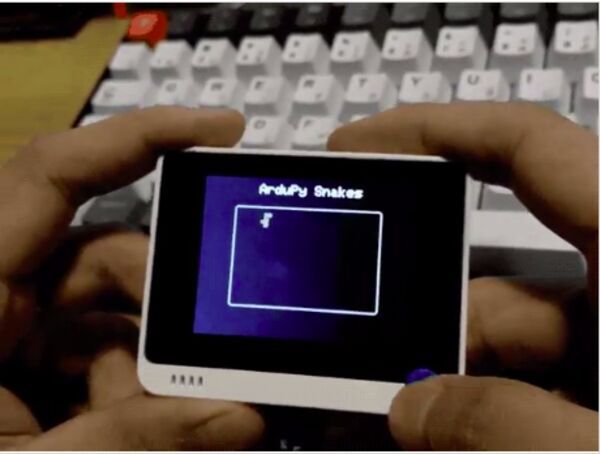
Playing Snakes on Seeed Wio Terminal
"With the help of ArduPy on Wio Terminal, you can create pixel games very easily using Python! This project is inspired by the GamerGorl Project. This snake game is ported from microPython to ArduPy for Wio Terminal. ArduPy Firmware First thing first, in order to use ArduPy(Python), you will need to load the ArduPy firmware into Wio Terminal. Please visit the official ArduPy get startedhere. Snake Game Code Once you have flashed the ArduPy Firmware to Wio Terminal, you should be able to see an ARDUPY USB drive appear in your PC." [...]

"UVC Box" a DIY UV Sterilizer
"A low cost easy to re-make UVC Sterilizer for killing germs and stuff" [...]
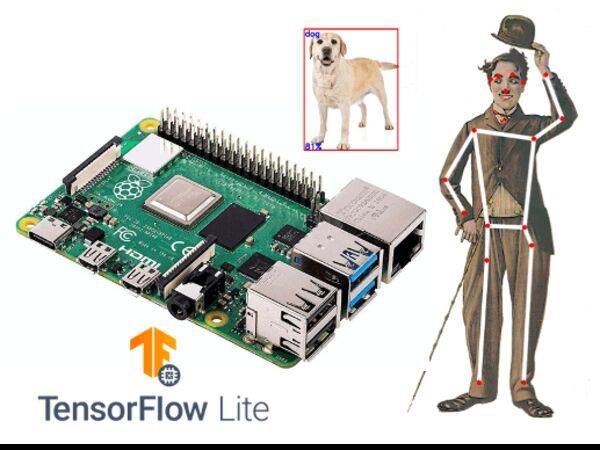
Exploring IA at the Edge!
"Image Recognition, Object Detection and Pose Estimation using Tensorflow Lite on a Raspberry Pi Introduction What is Edge (or Fog) Computing? Gartner defines edge computing as: “a part of a distributed computing topology in which information processing is located close to the edge — where things and people produce or consume that information.” In other words, edge computing brings computation (and some data storage) closer to the devices where it’s data are being generated or consumed (especially in real-time), rather than relying on a cloud-based central system far away. With this approach, data does not suffer latency issues, reducing the amount of cost in transmission and processing. In a way, it is a kind of “return to the recent past, ” where all the computational work was done locally on a desktop and not in the cloud. Edge computing was developed due to the exponential growth of IoT devices connected to the internet for either receiving information from the cloud or delivering data back to the cloud. And many Internet of Things (IoT) devices generate enormous amounts of data during their operations." [...]

Sixteen Segment Display
"The look of classic signage, be it neon tubes, wrought iron, or the use of distinctive typography and negative space, has a particular appeal. Unfortunately, the art form is dwindling due to the flexibility and flash that comes with newer LED arrays. Their distinctive styles have been giving way for the monotony of RGB LED panels. The Klais Display series, in which this panel is the first item, was inspired by the early electronic displays still seen in relics bygone from an era of cigarette machines, electronics test equipment, and pinball machines. Its been modernized, enlarged, and made easily integrable into your own projects, while retaining its beauty and elegance. " [...]
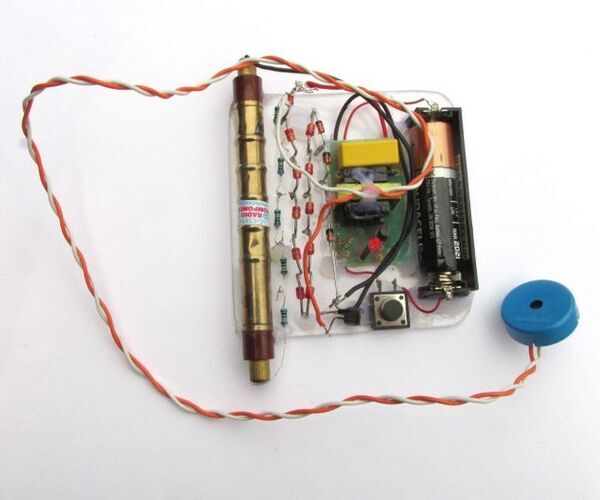
Working Geiger Counter W/ Minimal Parts
"Here is, to my knowledge, the simplest functioning Geiger counter that you can build. This one uses a Russian-made SMB-20 Geiger tube, driven by a high-voltage step-up circuit robbed from an electronic fly swatter. It detects beta particles and gamma rays, emitting a click for every radioactive particle or gamma ray burst it detects. As you can see in the above video, it clicks every few seconds from background radiation, but really comes to life when radiation sources such as uranium glass, thorium lantern mantles, or americium buttons from smoke detectors are brought near. I built this counter to help me identify radioactive elements that I need to fill out my element collection, and it works great! The only real drawbacks of this counter is that it isnt very loud, and it doesnt compute and display the amount of radiation it is detecting in counts per minute." [...]
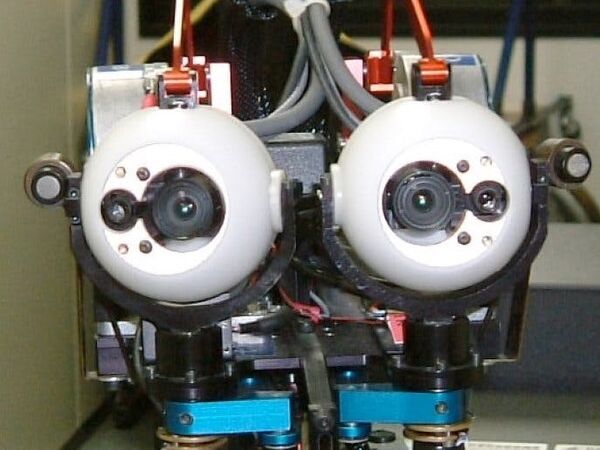
Stereo Dual-Sensor MEMS-Mirror Foveated Vision System
"A real-time foveated camera / foveated vision system. This project's goal is to implement FPGA/SoC design for real-time foveated camera and foveated FPGA-accelerated image processing pipeline implemented iTracker (MIT CSAIL), AlexNet-inspired CNN for foveation control by feed of Kalman filter and foveated two-stream (FVS) CNNs for video multi-frame summarization. Foveation is a biologically motivated image transformation which has attracted interest of researchers and of computer vision and robotics. Its principal advantages are the realization of high degree of image compression as well as property of scale and rotation invariance. Human eyes have fast mechanical movements that control how the scene is imaged in detail by the fovea, where visual acuity is highest. This concentrate computational(neuronal) resources in place where they are most needed." [...]
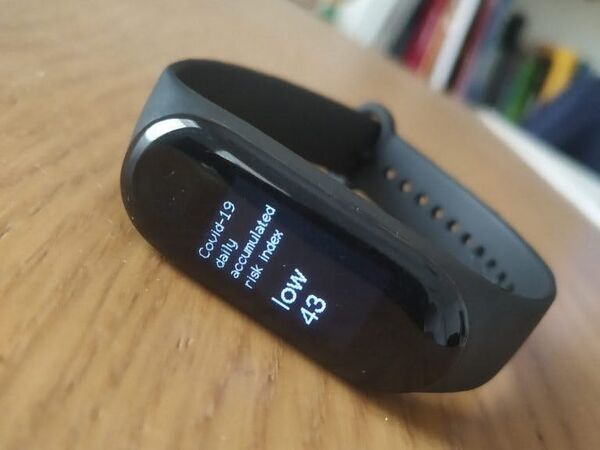
Covid-19 Personal Cumulative Risk Index Tracker
"Wireless wearable device to control if there is a safe distance between you and the flow of people around you. Inspired by the classic radiation dosimeters that we have seen in many documentaries and films, the idea of the project is to create a wearable device that allow us to measure the accumulated daily risk of exposure to potentially dangerous environments in relation to the transmission of covid-19. As we know, one of the main transmission factors of covid-19 is the proximity to other people who may be infected by the virus and therefore, one of the objectives to improve prevention is to be in environments where there is a safe distance between people and control the flow of movements around you. The covid-19 personal cumulative risk index tracker is a wireless device that is configured in promiscuous mode, thus acting as an electromagnetic spectrum analyzer at the frequencies used by wireless devices. Actually, almost everyone wears a device with a wireless connection on them, and every device with this type of connection, even if it is not connected to any network or in use, regularly emits a series of beacon signals to identify itself in a unique way. The covid-19 personal cumulative risk index tracker recognizes these signals and their intensity, density and variability, which allow us to know approximately the flow of people around you and based on that information, plus a real-time data of local infection cases, the device creates a reliable daily cumulative index of exposure risk, like the radiation dosimeters." [...]
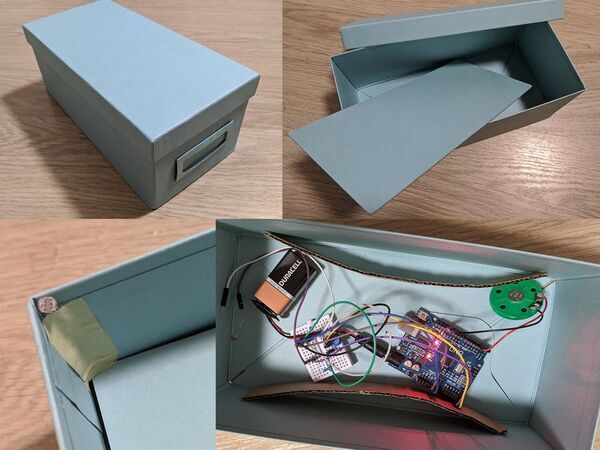
Musical Treasure Box
"Play a custom tune when your treasure box is opened to warn you someone may be trying to thieve your stuff! I teach coding and electronics at high school and my students often ask how to implement a music box or an alarm that sounds when the light level changes. They usually manage to get something working to turn the tune on, but have thus far struggled to make the tune cease playing mid way through. This project allows the maker to create their own tune to be played on a piezo buzzer with an analog input determining when the tune should stop. It can be used to create the musical treasure box but could also work well for a variety of other projects. Assumed knowledge: Able to build a circuit on a breadboard using a circuit diagram Understand how to edit and upload an Arduino sketch Know how to open the Serial Monitor and use the correct baud rate to track values Have a basic understanding of how music notes and duration of each note and rest is used to create a tune" [...]
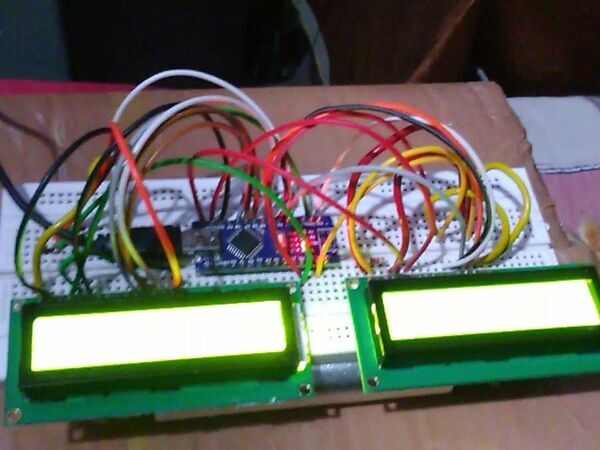
How to connect two 16*2 LCD together with arduino
"In this I will tell you how to connect two 16*2 LCD together with single arduino. This is a very unique project. you can't find this anywhere. In this project I will tell you that who to connect two lcd together with the help of Arduino only. When I was starting this project, I had to face many difficulties in making this project, I will share how you can make this project easily without any difficulty. I searched a lot about this project on the internet but I could not find any help related to it." [...]

Network Connected RGB Matrix Clock
"Build a beautiful, modern digital clock with a retro flair using CircuitPython, Metro M4 Airlift, RGB Matrix shield, and a 64 x 32 LED RGB pixel matrix display. WiFi connectivity with the Metro M4 Airlift keeps your clock in sync with internet time using Adafruit IO! Features The METRO Matrix Clock displays the time in the IBM Plex mono typeface, using a neon green hue for daytime hours, and red for nighttime hours. You can also enable or disable the blinking seconds colon in code. But that's it! Just a nice, minimal clock!" [...]
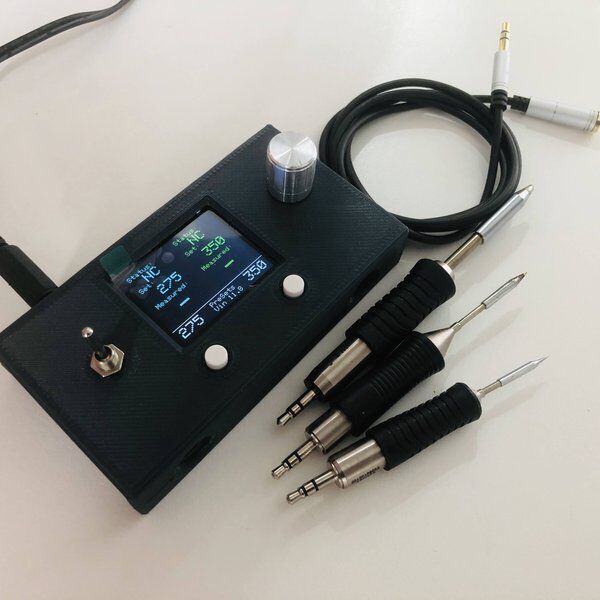
Soldering RT1
"Open Source Universal Weller RT Soldering Station with Tweezers support Soldering station compatible with Weller RT tips (12V 45W+ and more!!! ), custom developed, perfect for SMD work :). Tips supported: RT Micro/Pico/Ultra and SMD tweezers. Portable, compact, performant, plain simple!!! Tips supported: - RT Micro - RT Pico - RT Ultra - SMD tweezers Main features: - Two independent channels - 1.8" TFT full color LCD - Hardware mosfet support more than 10A continuous!! (repetitive peaks of more than 50A) - Easy to use and portable - Compatible with Weller RT1 - Open source - Fully Programmable (temperatures 150-450C, preset temperatures, power limitation to use various power supplies), also serial interface and source code available." [...]
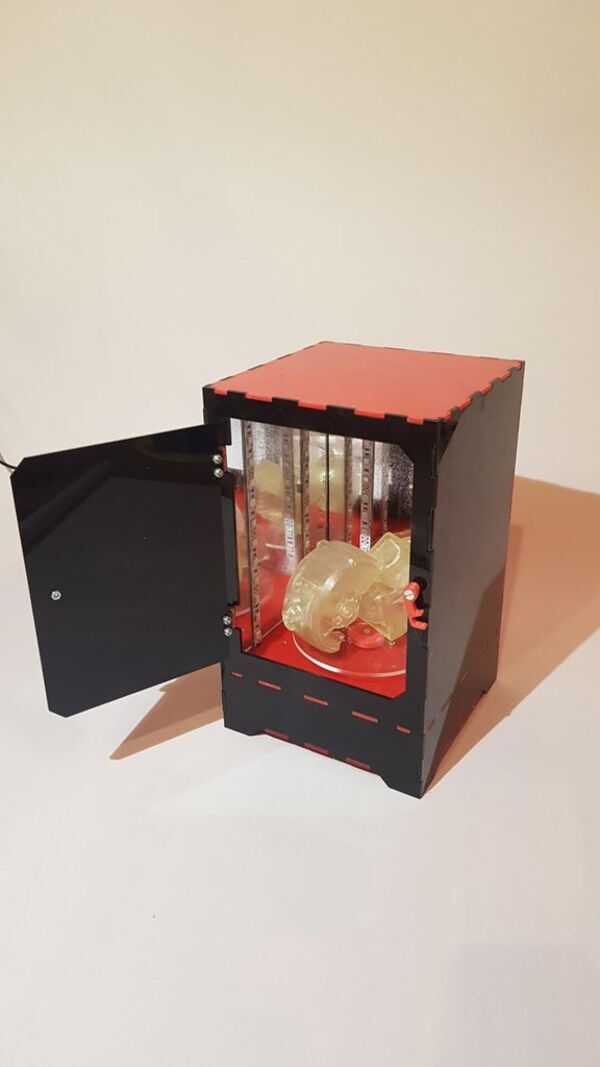
UV Curing Station
"UV curing station, a great tool for your resin 3D printer. For a while now i have a resin 3D printer, and i always had a problem with after curing of the 3D prints. Normaly i only printed when the sky was clear so i could cure the 3d prints in the sun. But i live in the Netherlands so it's more rain then sun. So i decided to make a uv curing box for my resin prints. Maybe you also have problems with curing your 3d prints, or you just want a cleaner solution." [...]

DIY Game Console Using Arduino
"In this tutorial I'm going to show you that how can you make a gaming console using Arduino nano. So if you want to see detailed video on it then check it out on my youtube channel Supplies:If you buy from this links it will help me give you more projects 1) ARDUINO NANO 2) OLED DISPLAY 3) PUSH BUTTONS 4) WIRES" [...]

Crystal Glass Beads and LEDs - a Kind of Kaleidoscope
"In this article, I propose the construction of a decorative object that is very easy to make and also very spectacular. Maybe you remember one of our favorite childhood toys, the kaleidoscope, with colored crystals and mirrors, all inserted in a cylinder in which you look and by rotating the cylinder you get an infinity of colored shapes? This object bears little resemblance to that kaleidoscope, only that here, the crystals, the transparent glass beads, stand still instead of moving and changing colors of the LEDs that illuminate the crystals. If you want to see how simple the construction of this pseudo kaleidoscope is, I invite you to continue reading my article. " [...]

Back To Basic Mini Cnc Plotter
"There are many projects and tutorials related to recycle old CD/DVD players into a mini CNC Plotter based on Arduino. I have become too concerned with complicated details or new things, and now I should concentrate on basic, simple and important ideas. Getting back to basics, to start learning CNC, today I'd like to share how to easily build your own low-cost Arduino Mini CNC Plotter. With my version, I used the spring part of stapler as a main component for pen lift. During the process of doing this, I have referenced from many sources, studied & tried to clarify some point hard to grasp. Let's getting started." [...]

GorillaBot the 3D Printed Arduino Autonomous Sprint Quadruped Robot
"Every year in Toulouse (France) there's the Toulouse Robot Race #TRR2021 The race consists of a 10 meter autonomous sprint for biped and quadruped robots. The current record I gather for quadrupeds is 42 seconds for a 10 meter sprint. So with that in mind I had to come up with a plan of designing a robot that I thought could beat that in order to become the new reigning champion!!! Seeking a bit of inspiration from a fellow Instructables member "jegatheesan.soundarapandian" and last year's winner of the Toulouse Robot Race "Oracid 1" who both seem to love designing and sharing tutorials on how to build quadrupeds. I got started on basically copying there design and making it a bit bigger! The design is based on a five bar linkage mechanism for each leg 2 servos power each leg for a total of 8 servos." [...]

DIY 10Hz-50kHz Arduino Oscilloscope on 128x64 LCD Display
"This project describes a way to make a simple oscilloscope that has a range from 10Hz to 50Khz. This is an extremely large range, given that the device does not use an external digital to analog converter chip, but only Arduino. " [...]
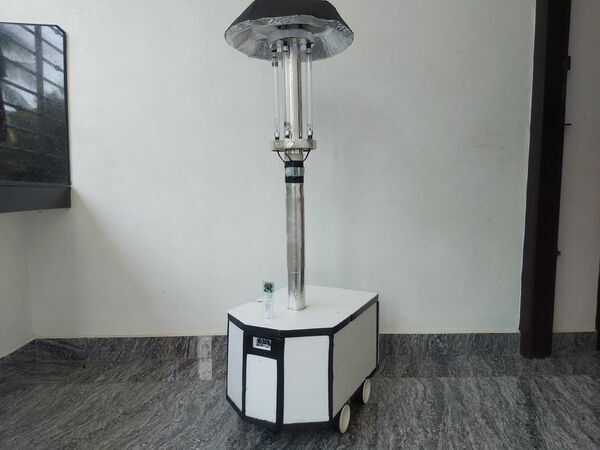
UV disinfection robot
"Ultraviolet disinfection remote controlled robot with automatic human detection and collision avoidance. In this amid pandemic the disinfection is very essential to prevent spreading viruses. It affected every walks of our life directly or indirectly. The disinfection is very difficult in crowded areas like hospital, shopping areas etc. So the low cost and sustainable solution is more acceptable in this case. The disease is transmitted by Bio-organisms such as bacteria and viruses." [...]
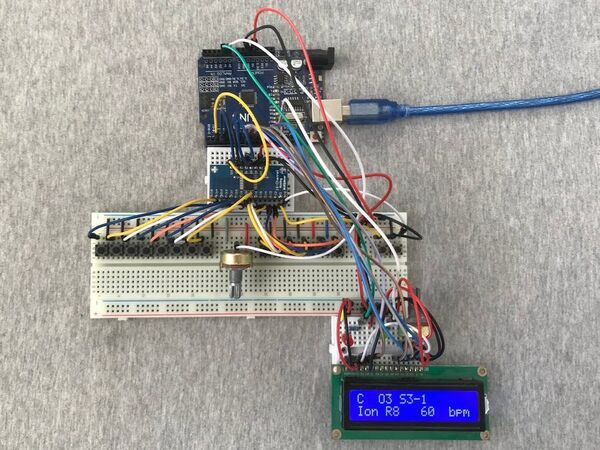
Arpeggino - MIDI arpeggiator, sequencer, recorder and looper
"Play MIDI arpeggios in every scale and pattern. Record and loop your sequences. Modify your sequences even after recording and be creative. What is Arpeggino Arpeggino is an Arduino based MIDI arpeggiator, sequencer, recorder and looper. By clicking on one of the keys, an arpeggio of the selected scale degree will start playing. With Arpeggino you can configure every aspect of the arpeggios while seeing the configuration on the LCD screen: - Root note of the scale (e.g." [...]

Isolated USB null modem
"Connect two hosts via a serial connection, but with total galvanic isolation I needed a way to connect two USB hosts via CDC devices. You could do so by just buying a pair of USB-RS232 dongles and connecting them with a null modem, but that still winds up connecting the two hosts' grounds together. If their grounds are not equipotential, the result could be disastrous. As you look at the schematic, note that there are two 5 volt rails and two grounds. Nothing is allowed to cross over the isolation barrier at all (except light inside the isolators). We need to move 3 signals in each direction." [...]
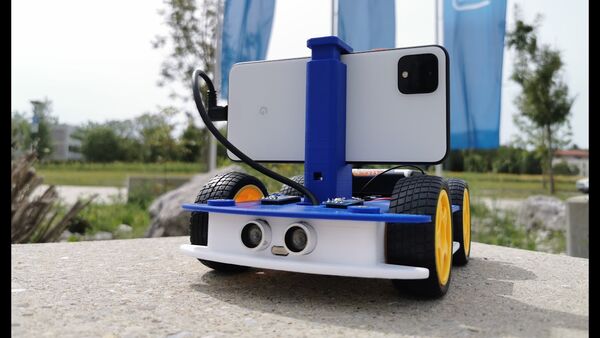
OpenBot: Turning Smartphones into Robots
"OpenBot leverages smartphones as brains for low-cost robots. We have designed a small electric vehicle that costs about $50 and serves as a robot body. Our software stack for Android smartphones supports advanced robotics workloads such as person following and real-time autonomous navigation. " [...]
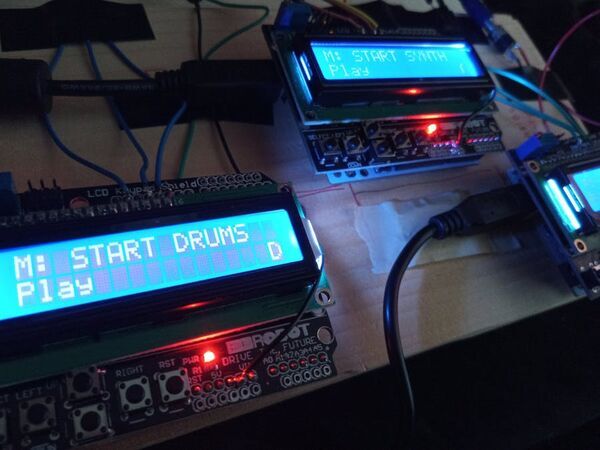
OscPocketO - Pocket Synth and Drum Machine
"Create your own music with OscPocketO, a synth and a drum machine, that can be synchronized! Inspired by other portable music making machines, I read up on the excellent Mozzi library. Wouldn't it be useful to be able to make a number of synths and drum machines and be able to synchronize them in tempo? OscPocketO was born - a portable music studio using only Arduino and a LCD keypad! TheOscPocketO is controlledby switching to different modes using the SELECT button. Use the UP button to increase a value, DOWN to decrease a value, and LEFT and RIGHT to move the cursor." [...]

RadioGlobe - Spin to Search Over 2000 Web Radio Stations!
"Ever wanted to explore thousands of the world's radio stations, in seconds, simply by spinning a globe? Then this is the project for you! This Instructables will show you how to build a 'RadioGlobe', which has over 2000 stations (and counting), from all over the world. Part of the magic is the the tension between familiarity and the unfamiliarity: It's both shocking how many radio stations play Western pop music, but then with a turn of the jog wheel, you find an alternatives (in the same location) - and you navigate from Boosh FM's Drum & Bass, to listening to a native dialect of New Zealand. It's frankly, mind-blowing, even though the technology has been around for years. News is another revelation - it's all too easy to lapse into thinking my 'international' news is 'the benchmark'." [...]

A Real-Time Well Water Level Meter
"These instructions describe how to build a low-cost, real-time water level meter for use in dug wells. The water level meter is designed to hang inside a dug well, measure the water level once a day, and send the data by WiFi or cellular connection to a webpage for immediate viewing and downloading. The cost for the parts to build the meter is approximately Can$200 for the WiFi version and Can$300 for the cellular version. The water meter is shown in Figure 1. A full report with building instructions, parts list, tips for constructing and operating the meter, and how to install the meter in a water well is provided in the attached file (Water Level Meter Instructions.pdf). The meters have been used to develop a regional, real-time shallow aquifer monitoring network in Nova Scotia, Canada: https://fletcher.novascotia.ca/DNRViewer/index.htm..." [...]

Hex Machine
"A simple gadget that translates binary numbers into hexadecimal. The Hex Machine is a simple gadget with four buttons and a seven-segment display. The user may press the buttons in any combination, and the display outputs the corresponding hexadecimal digit. Not very useful - just a fun little toy. Note: Be sure to check out the code! It's a nice demonstration of how much you can do with just a few lines when you use bit operators." [...]

Arduino Video Game Controller for any Computer
"Control any video game with this usb controller! The pro micro is an Arduino IDE-programmed board that can function as a USB keyboard or mouse. I took of this feature to create a video game controller. Each button triggers a key on your keyboard to be pressed or your mouse to scroll. The joystick controls your mouse location. With the combination of these two, you have full control of your games." [...]

COVID-Free Contactless Cordless Bell Using
"Year 2020, has taught us many new things. Our lifestyle has changed and we have adopted to many new and safe ways of livelihood. From social distancing to working from home, our main aim these days is to stay safe and avoid touching unnecessary objects. This project is an attempt to make a simple touchless cordless bell, without spending a lot from your pocket. " [...]

Mini Boss Battle
"A Little Boss Battle Against A Demon The is a game simulating a boss battle. You use the buttons to determine your attacks and change between screens. Your opponent (a demon) attacks using a random algorithm. I decided to make this as it's a fun idea and a throwback to old & retro videogames such as the original Pokemon and Super Mario games. The choices for attacks are:- The Blade Of Isin (2 Damage)- The Staff Of Kanas (1 Damage, +1 Attack)- The Spell Of Tories (0 Damage, +2 Attack)- The Potion Of Meseus (0 Damage, +2 Health)Good Luck & Have Fun! " [...]
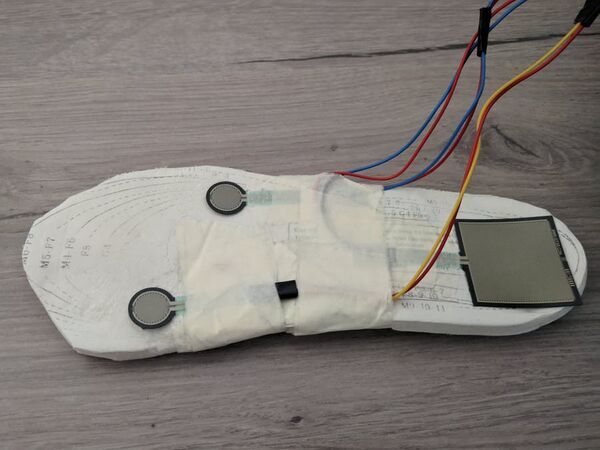
A DIY Smart Insole to Check Your Pressure Distribution
"The smart insole collects foot pressure data in real-time. Through Thinger.io the information is fed into a system that visualizes the data. Pressure measurement is already used in a variety of situations. It provides information about gait mechanics and has a wide range of applications, i.e. in clinical situations and in sports. In this project the sensors are used to gain insight about weight distribution." [...]
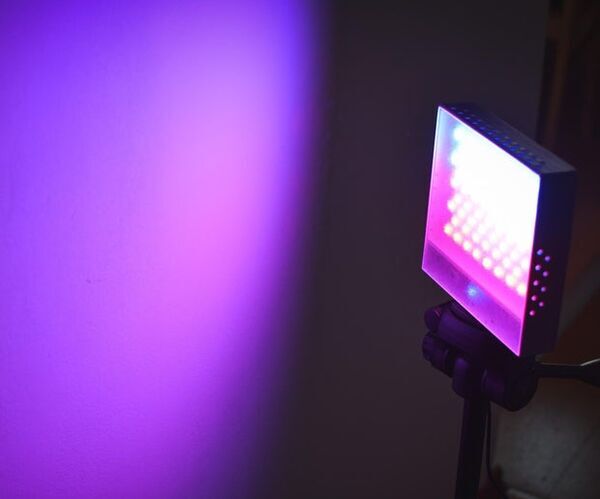
Build a Pocket RGB LED Light for Your Home Photo Studio
"The event that inspired me to start this project was the time when my daughter asked for my help to make some special photos. She isn’t a professional photographer but she is quite passionate about this art form and was looking forward to making some interesting photography. So we mixed my interest in leds with her inclination for taking pictures and created the project you are about to see described. There are already devices that incorporate colorful led lights (pocket rgb led lights) that are available on amazon, for example: AtomCUBE RX1 RGBCW Pocket Light Falcon Eyes F7 12W RGB Led Light Aputure MC Aputure RGB Led Video Light to enumerate just a few. The most useful thing that comes with using this kind of device in my opinion is the fact that you can change through colors slowly or at whatever speed you would like. It’s also amazing that you can control the hue and the saturation of the colors, so you can have an array of styles to choose from." [...]
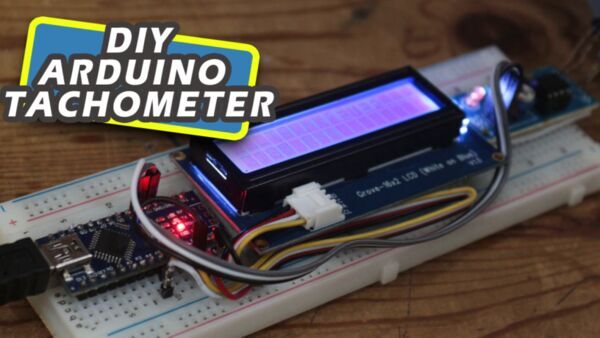
How to make Arduino based digital Tachometer or RPM counter
"Hello makers in this post we will see how simple you can build a Arduino based digital tachometer or RPM counter You can build this device quickly at home on your own, you only need few components listed below. Arduino Nano ( you can use UNO or Mega as well) IR Sensor module some jumper wires Bread Board 16 x 2 I2C display IR stands for infrared light, its non visible form of light. its wavelength is longer then visible light, so human eyes not able to see Infrared light. Ir sensor module have two IR diode one is transmitting IR light and one is receiving IR light. White surface reflect IR light and black surface absorb IR light. When IR sensor module is powered on IR transmitter emit IR rays if any white object came in front of IR transmitter so IR rays reflect from that body and IR receiver receive this rays and generate a 5V digital output at output pin with the help of LM358 IC." [...]

Self-Balancing Two Wheels Car
"A cool project to implement PID control! I started this project becasue back in the time when I was student I really like how things can be perfect controled using algorithms. So, I want to try to make my own self-balancing robot. " [...]

Aiie! - an embedded Apple //e emulator
"A Teensy 4.1 running as an Apple //e Teensy 4.1 (600 MHz arm Cortex M7) running a full-speed Apple //e emulator. Because everyone needs one of these, right? " [...]
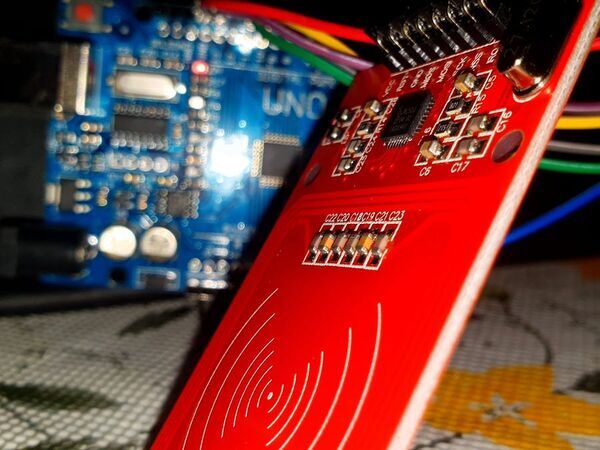
RFID scanner - Full tutorial
"A contactless and modern way of security. My project is a reflection, of the current COVID-19 pandemic, we are going through currently. Using ancient keys to unlock your assets, would now be considered unsafe and boring. Currently, right now, authorities are promoting anything regarding contactless operations to reduce the risk of contracting the virus. This made me question both important aspects of living in a COVID world where economic and health are brought to the question. Using this idea, I have made an RFID device which provides information to its serial monitor (the computer essentially)." [...]
That's all Folks!



